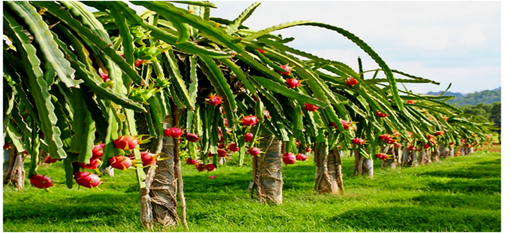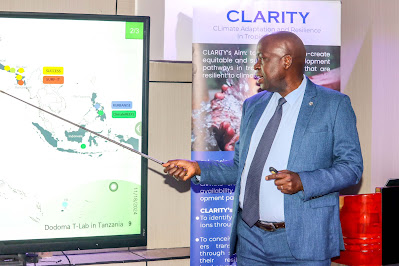
Dragon fruit, also known as pitaya, is a tropical fruit with a unique appearance and taste. In recent years, the global demand for dragon fruit has been on the rise due to its various health benefits and increasing disposable income of consumers, especially in developing nations. The fruit is primarily grown for the fresh market and is often sold through specialty stores and farmers’ markets. The United States imports the majority of its fresh dragon fruit from Southeast Asia, with Vietnam being the largest supplier. The global dragon fruit market is projected to register a CAGR of 3.9% over the forecast period (2022-2027)
In this article, we will explore the potential of dragon fruit, highlighting its global demand in the market, prices, and countries where it is cultivated mostly.
Agroforestry is a sustainable farming system that combines the cultivation of trees and crops in interacting combinations. Dragon fruit can be incorporated into agroforestry farming in Africa as it is a tropical fruit that can be grown in combination with other crops and trees. The legume species within an agroforestry system can influence the yield of dragon fruit, as shown in a study conducted in Ecuador
The cultivation of dragon fruit in agroforestry systems can provide a gateway toward income improvement for forest owners as it is a high-value crop with a growing demand in the global market
The production of dragon fruit is expanding in many countries, including those in Africa, such as Nigeria, Ghana, and Kenya. By incorporating dragon fruit into agroforestry systems, forest owners can diversify their income streams and contribute to sustainable land management for climate change mitigation and adaptation
2 NUTRITIONAL IMPORTANCE
DF comes in the category of functional foods due to its highly nutritious and nutraceutical properties. Nutritionally, it consists of vitamins such as vitamin C, vitamin A, and niacin, carbohydrates, proteins, fats, minerals such as potassium, sodium, calcium, phosphorus, zinc, magnesium, and iron, and fibers. The nutritional value of DF is given in Table 5 (Ali Jaafar et al., 2009; Liaotrakoon, 2013; To & Duc, 2000; USFDA, 2022). DF plays a beneficial role for health-conscious people because of the very low content of fat, lots of minerals, vitamins, higher amount of dietary fibers.
| Nutritional composition | WFDF | RFDF | RDA (%) |
|---|---|---|---|
| Moisture (%) | 85.3 | 82.5–83 | – |
| Total carbohydrates (g) | 11.2 | 11.2 | 4 |
| Fructose | 1.9 | 1.8–3.2 | – |
| Glucose | 5.5 | 4.7–5.7 | – |
| Fat | 0.1 | 0.21–0.61 | 0.13–0.78 |
| Sorbitol | 0.33 | – | – |
| Protein | 1.1 | 0.159–0.229 | 0.3–2.2 |
| Crude fiber | 1.34 | 0.7–0.9 | – |
| Vitamin C (mg/100 g) | 3 | 8-9 | 3–10 |
| Vitamin A | 0.0111 | – | 1.2 |
| Niacin | 2.8 | – | 17.5 |
| Potassium | 272 | 272–328.4 | 5.8–7 |
| Magnesium | 38.9 | 31.3–38.9 | 7.4–9.2 |
| Phosphorus | 27.5 | 27.5–36.1 | 2.2–2.8 |
| Calcium | 10.2 | 2.3–10.2 | 0.17–0.2 |
| Iron | 3.37 | 0.6–3.4 | 3.3–18.8 |
| Sodium | 8.9 | 7.3–8.9 | 0.32–0.38 |
| Zinc | 0.35 | – | 3.2 |
| Energy (KJ) | 130 | 283 | – |
- Abbreviations: RDA, recommended dietary allowance; RFDF, red flesh dragon fruit; WFDF, white flesh dragon fruit.
Tanzania can also use the opportunity presented by the growing demand for dragon fruit in the global market by incorporating it into agroforestry farming. Here are some ways Tanzania can benefit from dragon fruit cultivation:
- Dragon fruit plants are sustainable for tropical climates and can grow in regions with an altitude below 800 m (2625 feet). Tanzania has a tropical climate, which makes it suitable for dragon fruit cultivation.
- Dragon fruit is considered drought-tolerant, but fruit production can be maximized when the plants receive more than 800mm of rainfall annually. Tanzania has regions with low rainfall, and dragon fruit can be grown in these areas.
- Dragon fruit is a high-value crop with a growing demand in the global market. Tanzania can export dragon fruit to countries with a high demand for the fruit, such as China, the largest consumer of dragon fruit worldwide
- Dragon fruit cultivation can provide a gateway toward income improvement for forest owners in Tanzania. By incorporating dragon fruit into agroforestry systems, forest owners can diversify their income streams and contribute to sustainable land management for climate change mitigation and adaptation.
In summary, Tanzania can benefit from dragon fruit cultivation by incorporating it into agroforestry farming, which can provide a sustainable income source for forest owners and contribute to sustainable land management.




